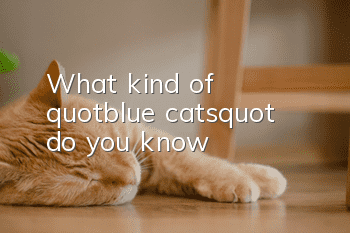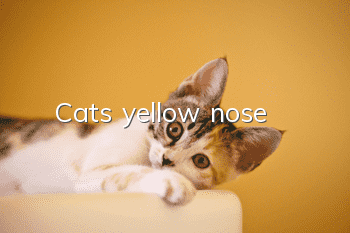What kind of "blue cats" do you know?

Many people say that they like cats very much, but they can't figure out the cat's breed. Sometimes they even make jokes, such as the problem of identifying "blue cats". Many friends who raise "blue cats" will readily blurt out "blue cats, I raise blue cats" when asked, "Which breed of cat is this?"
But in fact, the person being raised may be a British shorthair cat, a Persian cat, or a cute fold-eared cat. However, aren’t we talking about “blue cats”? How come there are so many professional cat names coming out all of a sudden? What is going on?
There are currently 42 cat breeds certified by CFA. Cats of different breeds have different standard characteristics, but there are some common characteristics among some breeds of cats. These classic characteristics have won the public's favor, and cats with a "blue" coat color are particularly eye-catching.
British shorthair cats have a gentle and calm temperament, are very easy to get close to, and have a gentlemanly demeanor that is now rare. For many cat lovers, British shorthair cats may not have as much personality as other cat breeds.
But it represents a long-lost British sentiment, just like the British royal family that has lost its glory and insists on its unique glory and aura. It will silently express its love for its owner.
The British shorthair cat is also the oldest cat breed in the UK, and its ancestors can be traced back to the domestic cats of ancient Rome. The cats were first admired for their physical strength and superb hunting prowess, but their calm demeanor, good tolerance and loyalty were soon equally recognized and valued.
At the end of the 19th century, British breeding expert Harrison Weir selected the most beautiful cats among these indigenous cats and began complex breeding work. In 1871, British shorthair cats participated in the Crystal Palace Exhibition in London, and the name of the breed was determined.
Due to a rare genetic mutation, this cat's ears fold forward like a hat on its head, resulting in a unique round head shape. Scottish Fold cats require particularly careful breeding to avoid certain skeletal problems associated with the genes that cause folded ears.
They have a sweet personality and like to participate in everything you do, but usually just sit quietly and make no noise to disturb you. Although their athletic talents are average, it does not mean that they do not like to play, but they prefer the company of their owners.
The first Scottish Fold cat discovered was a white long-haired female cat named Susie, who was born on a Scottish farm in the 1960s. It has white fur and clasped earsDuo, with an owl-like face.
At first, Susie and other fold-eared cats were not noticed by the locals. Later, a genetic expert discovered this phenomenon, brought Susie and other fold-eared cats to the United States and established breed breeding standards. In 1978, the Scottish Fold cat won the Cat Fanciers Association of America (CFA) championship.
At the end of the 19th century, the show of purebred cats had just begun to attract the world's interest. Persian cats, also known as long-haired cats, were already popular in the United Kingdom and the United States. After a long and ambiguous history in Europe, this luxuriously coated cat also stood on the show stage. The first recognized Persian cat breed was the monochromatic Persian cat. Persian cats are known for their gentle, friendly temperaments and love of their families.
In the UK, only solid-colored individuals are called Persian cats. Blue is one of the oldest coat colors. It appeared at the first cat show in 1871. According to Harrison Weir's report on January 27 of that year, several domestic cat breeds participating at that time included Persian cats, and it also caused a stir. sensation.
Korat cat, also known as silver cat, is native to the Khao Lat Plateau in northwestern Thailand, and its output is very rare. The fur color is silver-blue, the eyes are large and green, the face is heart-shaped, and the body shape is not as slender as a typical exotic short-haired cat. It is considered an auspicious animal.
The Korat cat is an ancient breed native to the Khao Lat Plateau in northwestern Thailand. This breed was introduced to the United States from Thailand in 1959 and was recognized by American cat lovers in 1965. It took 10 years for Britain to recognize this kind of cat.
The Korat cat, also known as the Korat cat, is named after a province in Thailand where it originated. It is known locally as "Sissawat", which means good luck. Thai people often give the bride a pair of these auspicious cats as a traditional wedding gift.
The Russian Blue cat (Russian Blue), historically known as the Achaian Blue cat, has had three different names. Originally the Achaian blue cat. It did not have its current name until the 1940s. There was also a time when it was called the Maltese cat.
The Russian Blue cat has a slender body, large, upright pointed ears, small and round paws, and looks like it is walking on its toes. The body is covered with silver-blue shiny short coat, coupled with the slender and slender figure and light gait, it shows the aristocratic demeanor among cats.
The ancestors originated from the cold Siberian zone and have a long history of evolution. Their ancestors, the Achaian blue cats, were brought to Britain from Russian ports as early as the 17th century. After World War II, the number of Russian Blue cats decreased sharply. In order to restore its population, breeders crossed it with Siamese cats, giving the Russian Blue cats some oriental appeal in appearance. Because its ancestors originated from the cold Siberian zone, many places call it the "winter elf"uo;.
It is said that in the 1860s, Russian blue cats were brought to England and Northern Europe by sailors from the Akandel Islands ("Blue Angel Islands"). It was only in 1875 that the Arkantiel cat (or "Blue Angel cat") was first registered at the Crystal Palace in England. It was not until 1912 that Russian blue cats were given formal class distinctions.
It is precisely because the mysterious feeling exuded by the shiny "blue coat" of cats is so charming that people have classified cats with "blue coat" into a group.
Many breeds of purebred cats, such as French Chartreuse cats, American Balinese cats, Tiffany cats, Nibilone cats, Russian Neva Masked cats, etc., will have blue in their coats. The editor will say in the future I will introduce it to you slowly over time. Just~ I wish everyone a happy weekend, bye!
- Six principles of cat training, pet cat training methods!
- Are halothrin mosquito coils harmful to cats?
- Does a cat have to weigh more than 6 pounds to be neutered?
- What medicine should be used for cat ringworm medicated bath?
- What to do if a nursing female cat catches a cold
- Can a kitten be bathed just after being vaccinated?
- How does a cat get used to a new environment?
- 3 major misunderstandings about how humans and cats get along. You think your cat despises you, but in fact it is saying it loves you.
- What colors do cats like? Cats are very poor at judging colors.
- Introduction to the functions of cat tails How to wash cat tails



